They said you are a woman: Who is Elizabeth Bugie?
Elizabeth Bugie played a very important and large role in the development of effective antibiotics against tuberculosis, but she did not receive any recognition for this.

Tuberculosis, which was very feared at the beginning of the last century, was a disease that was very difficult to treat. With streptomycin, an antibiotic discovered by Professor Selman Waksman, the condition of tuberculosis has changed drastically. Elizabeth Bugie, a graduate student of Professor Selman Waksman, played a very important and large role in this discovery, but she did not receive any recognition for it.
Successor to Penicillin!
Elizabeth Bugie worked as a graduate student in Professor Selman Waksman's microbiology laboratory. Professor Selman Waksman was looking for a highly worthy successor to penicillin. In 1943 she found a counterpart to streptomycin, the first antibiotic that proved to be highly effective against the bacteria that cause tuberculosis. The results of his research were published in the Proceedings of the Society for Experimental Biology. Alongside Professor Selman Waksman, Ph.D. students Albert Schatz and Elizabeth Bugie also took part as authors.
No Recognition!
Professor Selman Waksman received considerable praise for this discovery and was even awarded the Nobel Prize. He won many copyrights with the patent that Professor Waksman put in his name only. Albert Schatz felt he was entitled to be recognized as an exploration partner and to receive a share of these royalties, and as a result, he took legal action. The judge, who ruled in Albert Schatz's favor, was rather quiet about Elizabeth Bugie's role in the discovery of streptomycin. In the end, Elizabeth Bugie received 0.2% of the streptomycin royalties, but this was not a real recognition for her contribution.
Discovery of penicillin and entry into the age of antibiotics
Antibiotics are chemical substances that have the ability to inhibit or destroy the growth of various microorganisms. The age of antibiotics began when Alexander Fleming (1881-1955) discovered penicillin in 1928.
Elizabeth Bugie Gregory (October 5, 1920 – April 10, 2001) was an American biochemist who co-discovered Streptomycin, the first antibiotic against Mycobacterium tuberculosis in Selman Waksman laboratory at Rutgers University. Waksman went on to win the Nobel Prize for Medicine in 1952 and took the credit for the discovery.
But the true age of antibiotics began when Alexander Fleming discovered penicillin in 1928. According to Fleming, who published his article on his discovery in 1929, the substances secreted by the Penicillium notatum mold allowed the staphylococcal microbes to dissolve.
Penicillin, which was first used in the treatment of epidemic and infected diseases in 1941, was used extensively during the Second World War. In the first five months of 1943, 400 million units of penicillin were produced in the United States. Until the end of the Second World War, the monthly production of penicillin by US pharmaceutical companies was 650 million units. In the late 1940s, penicillin had become the main drug used in the treatment of many bacterial diseases, especially syphilis, pneumonia, and meningitis.
The discovery of penicillin also gave impetus to the search for other antibacterial agents. For example, streptomycin against tuberculosis bacillus was developed in 1943, and chloromycetin, which is effective against a broader spectrum of bacteria, was developed in 1947.
Discovery of streptomycin
Selman Waksman, who works at Rutgers Agricultural College in New Jersey, developed methods to screen certain molds for antibiotic properties in 1940 with his graduate students. During these studies, Waksman's graduate student Albert Schatz discovered that a mold called Streptomyces griseus was an antagonist of tuberculosis bacteria. Schatz developed methods for producing large quantities of Streptomyces, and in 1943 he was able to isolate the tuberculosis bacteria inhibitory agent, streptomycin, from cultures. Schatz and Waksman, together with Elizabeth Bugie in 1944, published their articles containing observation results and information about their discoveries, “Streptomycin; They published it in the journal Proceeding of the Society for Experimental and Biological Medicine (no. 55, pp. 66-69) with the title “A Substance Exhibiting Antibiotic Activity Against Gram-Positive and Gram-Negative Bacteria”.
Streptomycin began to be used in the treatment of tuberculosis in 1945. Waksman received the Nobel Prize in Physiology or Medicine in 1952 for this discovery. However, Albert Schatz and Elizabeth Bugie were not included in the award. Streptomycin brought tuberculosis under control and made sanatoriums unnecessary, leading to the disappearance of these treatment institutions.
The history of humanity cannot be separated from the great epidemics. The course of many historical processes and events has changed due to the consequences of epidemics and infectious diseases. The number of people who died from epidemics is tens of times higher than the number of people who died in wars from ancient times to the present. Antibiotics, especially penicillin, have saved the lives of millions of people.
--------------------------------
The Forgotten Women of the Antibiotics Race
https://www.ladyscience.com/features/forgotten-women-researchers-in-the-race-for-antibiotics-2021
